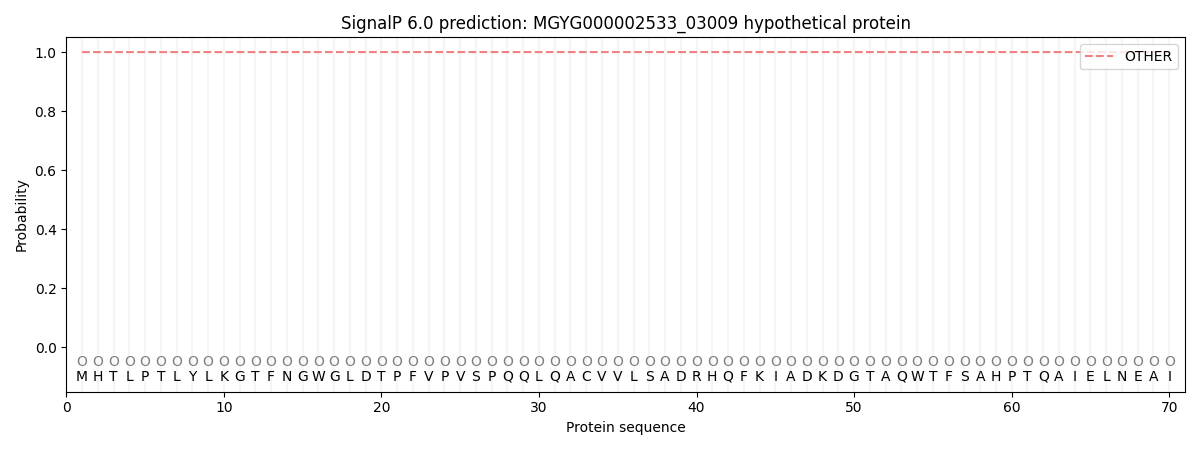You are browsing environment: HUMAN GUT
CAZyme Information: MGYG000002533_03009
You are here: Home > Sequence: MGYG000002533_03009
Basic Information |
Genomic context |
Full Sequence |
Enzyme annotations |
CAZy signature domains |
CDD domains |
CAZyme hits |
PDB hits |
Swiss-Prot hits |
SignalP and Lipop annotations |
TMHMM annotations
Basic Information help
| Species | Vibrio vulnificus | |||||||||||
|---|---|---|---|---|---|---|---|---|---|---|---|---|
| Lineage | Bacteria; Proteobacteria; Gammaproteobacteria; Enterobacterales; Vibrionaceae; Vibrio; Vibrio vulnificus | |||||||||||
| CAZyme ID | MGYG000002533_03009 | |||||||||||
| CAZy Family | GH133 | |||||||||||
| CAZyme Description | hypothetical protein | |||||||||||
| CAZyme Property |
|
|||||||||||
| Genome Property |
|
|||||||||||
| Gene Location | Start: 49064; End: 51844 Strand: - | |||||||||||
CAZyme Signature Domains help
| Family | Start | End | Evalue | family coverage |
|---|---|---|---|---|
| GH133 | 408 | 764 | 1.8e-89 | 0.9731182795698925 |
CDD Domains download full data without filtering help
| Cdd ID | Domain | E-Value | qStart | qEnd | sStart | sEnd | Domain Description |
|---|---|---|---|---|---|---|---|
| pfam06202 | GDE_C | 1.16e-169 | 401 | 765 | 10 | 374 | Amylo-alpha-1,6-glucosidase. This family includes human glycogen branching enzyme AGL. This enzyme contains a number of distinct catalytic activities. It has been shown for the yeast homolog GDB1 that mutations in this region disrupt the enzymes Amylo-alpha-1,6-glucosidase (EC:3.2.1.33). |
| COG3408 | GDB1 | 4.94e-48 | 385 | 804 | 243 | 635 | Glycogen debranching enzyme (alpha-1,6-glucosidase) [Carbohydrate transport and metabolism]. |
| TIGR01531 | glyc_debranch | 2.98e-19 | 414 | 761 | 1025 | 1455 | glycogen debranching enzymye. glycogen debranching enzyme possesses two different catalytic activities; oligo-1,4-->1,4-glucantransferase (EC 2.4.1.25) and amylo-1,6-glucosidase (EC 3.2.1.33). Site directed mutagenesis studies in S. cerevisiae indicate that the transferase and glucosidase activities are independent and located in different regions of the polypeptide chain. Proteins in this model belong to the larger alpha-amylase family. The model covers eukaryotic proteins with a seed composed of human, nematode and yeast sequences. Yeast seed sequence is well characterized. The model is quite rigorous; either query sequence yields large bit score or it fails to hit the model altogether. There doesn't appear to be any middle ground. [Energy metabolism, Biosynthesis and degradation of polysaccharides] |
| pfam17389 | Bac_rhamnosid6H | 3.62e-08 | 486 | 717 | 107 | 288 | Bacterial alpha-L-rhamnosidase 6 hairpin glycosidase domain. This family consists of bacterial rhamnosidase A and B enzymes. L-Rhamnose is abundant in biomass as a common constituent of glycolipids and glycosides, such as plant pigments, pectic polysaccharides, gums or biosurfactants. Some rhamnosides are important bioactive compounds. For example, terpenyl glycosides, the glycosidic precursor of aromatic terpenoids, act as important flavouring substances in grapes. Other rhamnosides act as cytotoxic rhamnosylated terpenoids, as signal substances in plants or play a role in the antigenicity of pathogenic bacteria. |
| cd02861 | E_set_pullulanase_like | 1.32e-06 | 6 | 49 | 12 | 55 | Early set domain associated with the catalytic domain of pullulanase-like proteins. E or "early" set domains are associated with the catalytic domain of pullulanase at either the N-terminal or C-terminal end, and in a few instances at both ends. Pullulanase (also called dextrinase or alpha-dextrin endo-1,6-alpha glucosidase) is an enzyme with action similar to that of isoamylase; it cleaves 1,6-alpha-glucosidic linkages in pullulan, amylopectin, and glycogen, and in alpha-and beta-amylase limit-dextrins of amylopectin and glycogen. The E set domain of pullulanase may be related to the immunoglobulin and/or fibronectin type III superfamilies. These domains are associated with different types of catalytic domains at either the N-terminal or C-terminal end and may be involved in homodimeric/tetrameric/dodecameric interactions. Members of this family include members of the alpha amylase family, sialidase, galactose oxidase, cellulase, cellulose, hyaluronate lyase, chitobiase, and chitinase. This domain is also a member of the CBM48 (Carbohydrate Binding Module 48) family whose members include maltooligosyl trehalose synthase, starch branching enzyme, glycogen branching enzyme, glycogen debranching enzyme, isoamylase, and the beta subunit of AMP-activated protein kinase. |
CAZyme Hits help
| Hit ID | E-Value | Query Start | Query End | Hit Start | Hit End |
|---|---|---|---|---|---|
| ALM72465.1 | 0.0 | 1 | 926 | 1 | 926 |
| ANH64827.1 | 0.0 | 1 | 926 | 1 | 926 |
| QMV39344.1 | 0.0 | 1 | 926 | 1 | 926 |
| QBN16198.1 | 0.0 | 1 | 926 | 1 | 926 |
| AIL72131.1 | 0.0 | 1 | 926 | 1 | 926 |
Swiss-Prot Hits download full data without filtering help
| Hit ID | E-Value | Query Start | Query End | Hit Start | Hit End | Description |
|---|---|---|---|---|---|---|
| Q06625 | 3.21e-12 | 394 | 708 | 1050 | 1453 | Glycogen debranching enzyme OS=Saccharomyces cerevisiae (strain ATCC 204508 / S288c) OX=559292 GN=GDB1 PE=1 SV=1 |
| P35574 | 1.90e-08 | 397 | 710 | 1092 | 1490 | Glycogen debranching enzyme OS=Oryctolagus cuniculus OX=9986 GN=AGL PE=1 SV=1 |
| Q2PQH8 | 3.26e-08 | 397 | 495 | 1070 | 1165 | Glycogen debranching enzyme OS=Canis lupus familiaris OX=9615 GN=AGL PE=2 SV=1 |
| A8BQB4 | 7.36e-08 | 414 | 495 | 1087 | 1165 | Glycogen debranching enzyme OS=Equus caballus OX=9796 GN=AGL PE=2 SV=1 |
| P35573 | 1.27e-07 | 397 | 495 | 1069 | 1164 | Glycogen debranching enzyme OS=Homo sapiens OX=9606 GN=AGL PE=1 SV=3 |
SignalP and Lipop Annotations help
This protein is predicted as OTHER

| Other | SP_Sec_SPI | LIPO_Sec_SPII | TAT_Tat_SPI | TATLIP_Sec_SPII | PILIN_Sec_SPIII |
|---|---|---|---|---|---|
| 1.000044 | 0.000000 | 0.000000 | 0.000000 | 0.000000 | 0.000000 |
